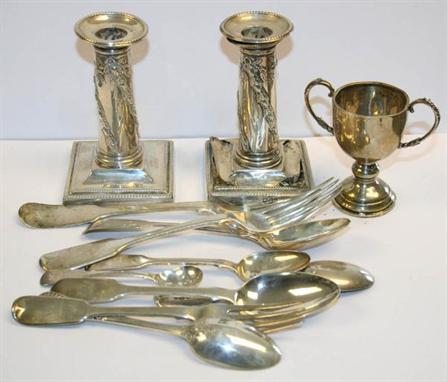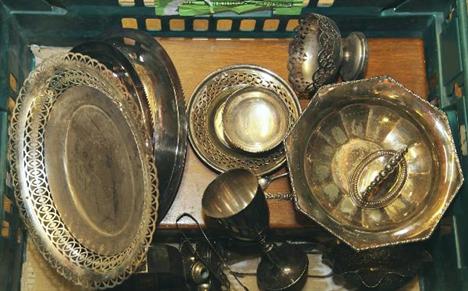A Victorian silver helmet shaped cream jug by James Deakin & Sons, Chester 1892, on pedestal foot to a square base; a George III silver fish slice, London 1802, with pierced and engraved decoration to include a crest (handle missing); a set of six silver Dutch figural finial teaspoons, import marked by Samual Boaz Landeck, London 1892; a set of nine silver teaspoons, London 1910; a set of six Victorian silver fish knives by John Gilbert, Birmingham 1863; 21oz gross, together with nine further items of silver and plated flatware
36796 Preisdatenbank Los(e) gefunden, die Ihrer Suche entsprechen
36796 Lose gefunden, die zu Ihrer Suche passen. Abonnieren Sie die Preisdatenbank, um sofortigen Zugriff auf alle Dienstleistungen der Preisdatenbank zu haben.
Preisdatenbank abonnieren- Liste
- Galerie
-
36796 Los(e)/Seite
A silver navette half reeded sugar basin by The Goldsmiths & Silversmiths Co. Ltd, Sheffield 1901, engraved with a crest and a motto `Nobilis Est Ira Leonis`, 16cm (6.25in) long; a late Victorian tapered cheroot holder case, Birmingham 1898; various small flatware; and an American silver coloured butter knife, 11.75 oz gross The crest and motto belongs to the name of Stuart, a kinsman of the Marquesses of Bute. The first husband of Mrs Knatchbull Hugesson of Ropley House was Lord James Charles Crichton-Stuart, son of Sir John Crichton-Stuart, 5th Marquess of the County of Bute and Lady Eileen Beatrice Forbes. Provenance: Ropley House, Alresford, Hampshire
A collection of Old English pattern flatware, various dates and makers, comprising:- three George III tablespoons, London, 1811 and 1814 one Victorian dessert spoon, London 1847 nine Georgian teaspoons, London 1794 to 1825 together with an assortment of decorative finial teaspoons and a silver handled knife 16.08oz
A collection of silver flatware, including a George III gravy spoon by Stephen Adams II, London 1798, engraved with initials; a George III table spoon by John Lambe, London 1788; another, by Jeremiah King, inscribed with initials `ML to GW 30 Jan 1741`; another two, by William Sumner, London 1782 and 1787; a Victorian table spoon, London 1863; three George IV salt spoons by John Wakefield, London 1822; a pair William IV sugar tongs, London 1836; and another Victorian pair, Chester 1840, 16oz gross
A collection of Russian silver flatware, including: an Old English pattern soup ladle, St Petersburg 1802, 84 zolotniks, 36cm long; a fiddle pattern soup ladle, post 1908 Kokoshnik mark for Moscow, 84 zolotniks, engraved with a monogram, 32cm long; eight fiddle pattern table spoons; three table forks and a tea spoon, 39.55 oz gross
A parcel of thirty one pieces of silver shell handled flatware, some pieces monogrammed - six teaspoons 7.5 ozs, London 1840, six dessert forks 12.5 ozs, London 1836, six dinner forks 21 ozs, London 1846, six dessert spoons 13 ozs, London 1840, six serving spoons 20 ozs, London 1840 and a ladle 3 ozs, London 1913 (non-matching) - approximately 77 ozs total (catalogue illustrated)
An assorted selection of silver flatware to include; A Russian silver spoon, bearing mark for Moscow circa 1884, marked indistinctly, with basket weave effect decoration, 13.5cm long, along with a silver basting spoon probably Stephen Adams, late 18th century, a silver ladle, Solomon Hougham, Solomon Royes and John East Dix, London 1817, with crest, five silver teaspoons with shell moulded bowl and various further spoons, total weight 10oz
A selection of silver fiddle pattern flatware, to include; six silver dessert spoons, four by Elizabeth & John Eaton, London 1858 and two H J Lias & Son, London 1852, six dessert forks Samuel Hayne and Dudley Cater, London 1860 and six table forks by the same maker also London 1860, total silver weight 35oz and eleven various ivory effect handled knives
`The Barncleuch` Puritan spoon - an important Scottish 17th century puritan spoon by George Cleghorne, Edinburgh 1653 - 1655, Deacon Andrew Burrell, the tapered stem with three V cut notches to terminal and incised decoration to stem above large oval bowl, the reverse with large zig zag assay scrape and bottom marked, the reverse of the bowl with short V shaped rat tail and engraved with contemporary initials `QH / MD` 19.2cm long, 65g Provenance: Reputedly found in the gardens of Barncleuch House Thence by descent Sotheby`s Gleneagles, 30th August 1982 lot 483 (front and back illustrated) How of Edinburgh, 1993 Private Collection Exhibitions: Silver; Made In Scotland` item 3.47, National Museums of Scotland 2008 References: Compendium of Scottish Silver, volume 1 page 239, R & J Dietert Silver; Made In Scotland` page 52 item 3.47, piece and marks illustrated, G Dalgleish & H Steuart Fothringham Notes: The survival of Scottish Puritan spoons is surprisingly rare when compared to the same style and period of English examples. To date only nine hallmarked or provincial examples are known and this example being the earliest. It is unknown why this pattern should be so rare in Scotland when it is such a standard and comparably common pattern in English silver. It must be considered that a large number have been melted down and re fashioned throughout their history and lost. However even when compared to the other patterns of early Scottish flatware their survival still seems remarkably small. Even within such a small survival fashions and trends can be noticed. While following the English examples the Scottish made pieces do show variation. Due to its early manufacture this piece must be considered one of the plainer examples, virtually without additional decoration to the stem, other than the almost standard three V cut notches to terminal. The addition of the simple incised decoration above the bowl being it`s only additional adornment and unique to this spoon. For a full listing of currently recorded Scottish Puritan spoons see `An important new discovery in early Scottish silver` The Finial September / October 2008. Another interesting angle to this spoon are the engraved owners initials to the reverse of the bowl; with the original source of Barncleuch, it does appear that the upper initials `QH` stand for Quintin Hamilton of Barncleuch and it must be assumed the lower set `MD` for Marion Denham his wife, the date of marriage so far remains untraced but is presumably roughly contemporary to the spoon. Little is known about Quintin Hamilton other than he succeeded his father James Hamilton and took over the house and gardens at Barncleuch which had been constructed by his grandfather John Hamilton of Barncleuch, Commissary of Hamilton and Campsie in 1583. While the house at Barncleuch was of no great note within Scottish stately home architecture it was the gardens created by John Hamilton that really stood out. These terraced gardens he created with great vision and ambition carving five terraces into the steep hillside from the house to the river Avon and carried out large amounts of structural work. His visions and creations were no doubt inspired by his experiences travelling the world which consumed a large part of his life. Quintin and Marion are believed to have had five children and upon Quintin`s death in circa 1680 he was succeeded by his eldest son John who in turn died on 21st February 1705 without direct heir. References: `Historical and Genealogical Memoirs of the Branches of the House of Hamilton`, John Anderson 1825 pages 221 - 3 and supplement page 420 - 2
A silver spoon, with a cherub`s head terminal, detailed DRYAD, Birmingham 1921 and a quantity of mostly plated table flatware, including; six pairs of fish knives and forks with ivory handles, a set of six pastry forks, a preserve spoon, a butter knife and various knives, forks and spoons, with an oak cutlery box.
Two silver and mother of pearl folding fruit knives, three Victorian silver fiddle pattern spoons, London 1847, a silver salt shovel, London 1823, two silver teaspoons, a Foreign spoon, a pair of nutcrackers, the handles detailed 800 and a quantity of plated flatware, including a pair of serving tongs and three pairs of sugar tongs.
* A collection of Continental flatware, including: a Danish silver-mounted Royal Copenhagen letter opener, the blade stamped with Juliane Marie mark, Dutch import mark .925 standard, the porcelain handle hand painted in the 18th century style with song birds amongst gilded scroll-work, with a matching gilt metal knife and fork; and an Austro-Hungarian silver-gilt three-piece cutlery set with agate handles, and a gilt metal spoon (unmarked)
A collection of silver small flatware, including: a set of six cake forks and a serving fork, Birmingham 1936, in a case; two cased two-piece christening sets, of a fork and spoon; a late Victorian silver gilt and coloured enamel commemorative spoon, with a scene to the bowl `The Houses of Parliament and Table Mountain`, the stem with `South Africa`, the armorial terminal with a motto `Spes Bona`, in a case; twelve late Victorian Old English shell `fancy back` tea spoons, London 1899-1900, the back designs differing; a set of six Old English tea spoons, probably London 1806 (no town mark), engraved `S` over `C*M`; and three other items, 506g (16.25 oz) gross
A collection of silver flatware, George III and later dates and makers; five various napkin rings; an Edwardian silver mounted small photo frame, Birmingham 1906, embossed with Art Nouveau flowers; and a set of six Albany pattern tea spoons by Walker & Hall, Chester 1900, in a case, 820g (26.35 oz) gross weighable
A collection of silver and silver coloured small flatware, various George III and later makers and dates, including: a George III Old English sifter spoon, London 1795; a George IV fiddle pattern example, London 1825; an Onslow pattern sauce ladle, maker`s mark `IL` only, engraved with a crest; and others, mainly tea spoons, including silver coloured, 21 oz gross
A collection of small silver, including: a Georg Jensen silver mounted corkscrew, import marked for London 1982; two tapered loaded vases, Birmingham 1910? and 1979; an Edwardian embossed card case by H. Matthews, Birmingham 1904; other silver, silver mounted and silvered coloured items, mainly small flatware, 447g (14.3 oz) gross weighable
A small quantity of silver, comprising: two sugar tongs; a five cherub head pattern hand mirror, Birmingham 1916; a footed sweet dish, Sheffield 1958; and an Indian silver coloured chased bowl; together with a quantity of electro-plated wares, including: an oval galleried tray; cased and other flatware
A SELECTION OF SILVER AND SILVER COLOURED METAL FLATWARE AND CUTLERY comprising 12 mixed coffee spoons, 3 tea knives with plated blades, mustard spoon, 2 jam spoons, 2 tablespoons, silver handled bread knife and cake fork with plated blade and tines, weighable silver 330g, 6 Albany pattern EPNS soup spoons, a salt and another teaspoon
-
36796 Los(e)/Seite

















































